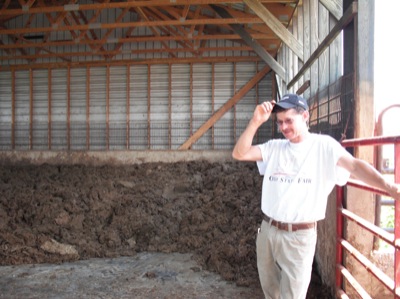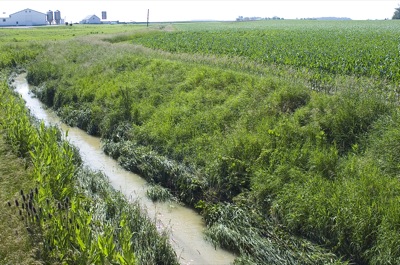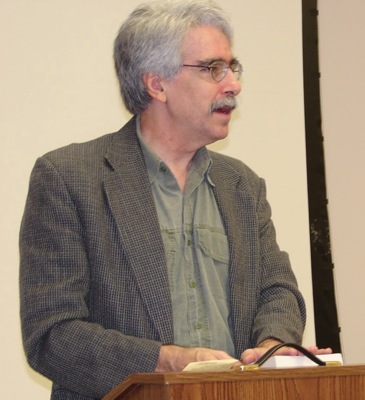Monday, June 29th, 2009
Watershed woes
Lake supporters say conservation efforts so far not enough; farmers say they're trying and need more time
By Nancy Allen

Photo by Nancy Allen/The Daily Standard
Jerry Will Jr. of St. Sebastian stands inside a manure storage barn on the farm he operates with his brother, Tim. Funds available to Grand Lake Watershed farmers helped Will pay to put up the structure, which keeps rainwater off the manure and greatly reduces the chance it will end up in a waterway.
A lot of fingers have been pointed at farmers and what drains off their land into Grand Lake since a recent announcement of a harmful algae toxin in the lake.
Local farmers say that's unfair.
Ag leaders say they are upset with a push by the nonprofit Lake Improvement Association (LIA) asking Gov. Ted Strickland to declare the lake and its watershed area a "phosphorous free" zone - a move they say would hurt their farm operations and be difficult to police.
In particular, they take offense to a letter sent by this group to Strickland that says "the limited actions taken to date to stem the flow of phosphorous into the lake have been ineffective, at best."
"I couldn't be more disappointed in that statement," said Chris Gibbs, executive director of the Mercer County Farm Service Agency (FSA). "The work that's been done by soil and water, Pheasants Forever, FSA, NRCS and most of all, producers in the watershed is well documented ... I do not accept that those efforts have been either limited or ineffective."
There has been progress in getting farmers to install conservation practices on their land, but time is needed to see results, ag officials say.
More than $2 million for conservation efforts has been leveraged in recent years by local and state legislators, who have come under increasing public pressure to address the lake's water quality problem.
Congressmen John Boehner and Senator Sherrod Brown steered $1 million to Mercer and Auglaize County farmers last year, allowing them to install 2,161 acres of winter cover crops, 794 acres of hayland buffers and seven manure storage structures. All of this was done in the lake's watershed.
Another million was made available this year for more practices, which won't be installed until probably this fall. The deadline for watershed farmers to apply for those funds was Friday.
Sen. Keith Faber, R-Celina, brought home roughly $200,000 in state budget funds for 2007 and 2008. This allowed farmers in the watershed to install 71.34 acres of grass buffers, recharge areas and waterways, 11 tile control structures, 2,061.8 acres of winter cover crops, two manure pumping shutoff systems and a milkhouse wastewater treatment system. Producers also used the funds for manure and soil sampling for more than 360 acres and one comprehensive nutrient management plan.
Along with the state and federal money legislators directed to the watershed, the local FSA office also administers funds through different nationwide conservation programs. Those funds have helped Mercer County farmers install 4,372 acres of filter strips, buffers and other conservation practices that help water and wildlife; 80 percent of those practices are in filter strips. However, only 10 percent of those practices are located in the watershed area that drains into the lake.
There also has been a particularly hard push for winter cover crops in the watershed, and producers answered by planting 4,222 acres of them in recent years. Flow studies done by the Ohio EPA indicate that most of the nutrients that get into the watershed and lake do so in the fall and winter months, after crops have been harvested and manure is spread on bare ground.
Laura Walker, coordinator of the Grand Lake/Wabash Watershed Alliance, said more producers are installing conservation practices that help the lake, but it is a slow process.
The phosphorous free zone the LIA is asking the governor to approve would be difficult to set up and police, she said.
"There are a lot of intricate details that would need to be figured out and you would need someone to police it," Walker said. "There are some rural areas in Wisconsin that have done it, but they don't have the livestock we have."
Walker said such areas that have been declared phosphorous free also allow for people to file for exemptions.
"We'd be better off continuing to educate these guys to use manure where they need it and get them to understand it's to be used as a nutrient rather than just as a way to get rid of waste," she said.
Walker said Grand Lake's water quality problems are not caused by point source polluters, which are easier to spot and fix, but rather it is widespread, constant, little-by-little runoff of nutrients throughout the entire area.
"With nonpoint source it's a lot of little places and small areas that add up to a problem, which are very hard to find," she said. "That's what we have here."
Walker said the funds that have come to the watershed to pay farmers to try different types of conservation have been a tremendous help, but there is still lots of work to be done.
"For us, we have just started going uphill," she said. "It will take awhile to see improvements."
At a glance:
The Grand Lake Watershed, which has been deemed one of the most degraded in the state based on Ohio EPA tests, is located in Mercer and Auglaize counties with most of the drainage area located in Mercer County. The watershed area includes a high concentration of large livestock farms.
Excess nutrients, particularly phosphorous, feed the blue-green algae in Grand Lake. Recent test reports show the algae has been producing a toxin called microcystin that can be harmful to humans and small animals.
While the overabundance of nutrients that feeds the lake's blue-green algae comes from many sources, most of the sediment and nutrients that flow into the shallow manmade lake come from runoff from farmland, EPA tests show. This is because farmland makes up the greatest number of acres in the watershed.
- Nancy Allen

Photo by Mark Pummell/The Daily Standard
Steve Homan of Chickasaw installed this filter strip on his farm. The filter strip, planted between a stream and cornfield, helps prevent runoff from the land getting into the water.

